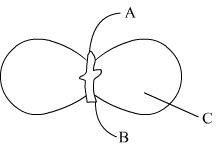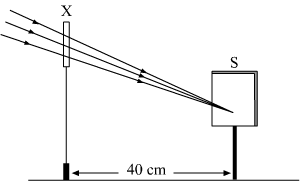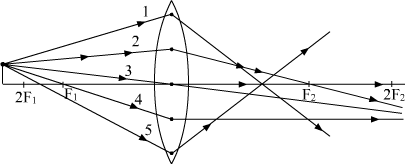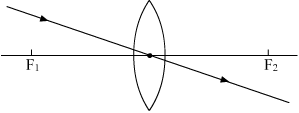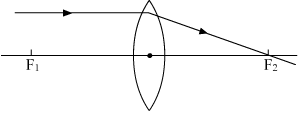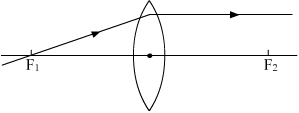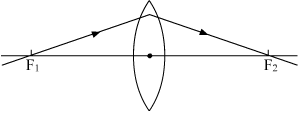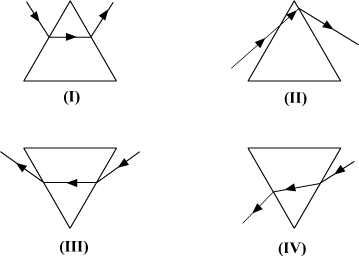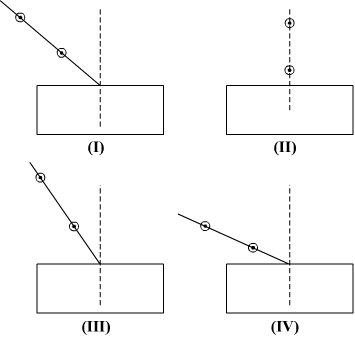Board Paper of Class 10 2013 Science Delhi(SET 3) - Solutions
(i) The question paper comprises of two Sections, A and B. You are to attempt both the sections.
(ii) All questions are compulsory.
(iii) All question of Section-A and all questions of Section-B are to be attempted separately.
(iv) Question numbers 1 to 3 in Section-A are one mark questions. These are to be answered in one word or in one sentence.
(v) Question numbers 4 to 7 in Sections-A are two marks questions. These are to be answered in about 30 words each.
(vi) Question number 8 to 19 in Section-A are three marks questions. These are to be answered in about 50 words each.
(vii) Question numbers 20 to 24 in Section-A are five marks questions. These are to be answered in about 70 words each.
(viii) Question numbers 25 to 42 in Section-B are multiple choice questions based on practical skills. Each question is a one mark question. You are to select one most appropriate response out of the four provided to you.
- Question 1
Write two reasons responsible for the late discovery of noble gases?
VIEW SOLUTION
- Question 2
List any two measures that you suggest for better management of water resources.
VIEW SOLUTION
- Question 3
“Cell division is a type of reproduction in unicellular organism.” Justify. (1)
VIEW SOLUTION
- Question 4
(a) Trace the path of sperms from where they are produced in human body to the exterior. (2)
(b) Write the functions of secretions of prostate gland and seminal vesicles in humans.
VIEW SOLUTION
- Question 5
A ray of light falls normally on the surface of a transparent glass slab. Draw a ray diagram to show its path and also mark angle of incidence and angle of emergence. (2)
VIEW SOLUTION
- Question 6
List and explain any two advantages associated with water harvesting at community level.
VIEW SOLUTION
- Question 7
We often observe domestic waste decomposing in the bylanes of residential colonies. Suggest ways to make people realise that the improper disposal of waste is harmful to the environment.
VIEW SOLUTION
- Question 8
What happens when :
(a) ethanol is burnt in air,
(b) ethanol is heated with excess conc. H2SO4 at 443 K,
(c) a piece of sodium is dropped into ethanol ?
VIEW SOLUTION
- Question 9
Why homologous series of carbon compounds are so called? Write chemical formula of two consecutive members of a homologous series and state the part of these compounds that determines their (i) physical properties, and (ii) chemical properties.
VIEW SOLUTION
- Question 10
The elements Li, Na and K, each having one valence electron, are in period 2, 3 and 4 respectively of modern periodic table.
(i) In which group of the periodic table should they be ?
(ii) Which one of them is least reactive ?
(iii) Which one of them has the largest atomic radius ? Give reason in justify your answer in each case.
VIEW SOLUTION
- Question 11
Given below are some elements of the modern periodic table: (3)
4Be, 9Fe, 14Si, 19K, 20Ca
(i) Select the element that has one electron in the outermost shell and write its electronic configuration.
(ii) Select two elements that belong to the same group. Give reason for your answer.
(iii) Select two elements that belong to the same period. Which one of the two has bigger atomic size?
VIEW SOLUTION
- Question 12
Write two examples each of sexually transmitted diseases caused by (i) virus, (ii) bacteria. Explain how the transmission of such diseases be prevented? (3)
VIEW SOLUTION
- Question 13
(a) Name the following : (3)
(i) thread like non-reproductive structures present in Rhizopus.
(ii) ‘blobs’ that develop at the tips of the non-reproductive threads in Rhizopus.
(b) Explain the structure and the function of the structures released from the ‘blobs’ in Rhizopus.
VIEW SOLUTION
- Question 14
“The sex of a newborn child is a matter of chance and none of the parents may be considered responsible for it.” Justify this statement with the help of flow chart showing determination of sex of a newborn. (3)
VIEW SOLUTION
- Question 15
What are fossils? State their importance in the study of evolution with the help of a suitable example. (3)
VIEW SOLUTION
- Question 16
An object of height 4 cm is kept at a distance of 30 cm from a concave lens. Use lens formula to determine the image distance, nature and size of the image formed if focal length of the lens is 15 cm. (3)
VIEW SOLUTION
- Question 17
Mention the types of mirrors used as (i) rear view mirrors, (ii) shaving mirrors. List two reasons to justify your answers in each case. (3)
VIEW SOLUTION
- Question 18
State the difference in colors of the sun observed during sunrise/sunset and noon. Give an explanation for each.
VIEW SOLUTION
- Question 19
(a) What is an ecosystem? List its two main components.
(b) We do not clean ponds or lakes, but an aquarium needs to be cleaned regularly. Explain.
VIEW SOLUTION
- Question 20
(a) Draw a sectional view of human female reproductive system and label the following parts : (5)
(i) Where the development of egg occurs.
(ii) Where fertilization takes place.
(b) Describe the changes the uterus undergoes :
(i) to receive the zygote.
(ii) if zygote is not formed.
VIEW SOLUTION
- Question 21
(a) Identify A, B and C in the given diagram and write their functions. (5)
(b) Mention the role of gamete and zygote in sexually reproducing organisms.
VIEW SOLUTION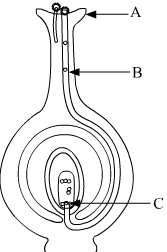
- Question 22
(a) Define the term ‘isomers’.
(b) Draw two possible isomers of the compound with molecular formula C3H6O and write their names.
(c) Give the electron dot structures of the above two compounds.
VIEW SOLUTION
- Question 23
(a) A person cannot read newspaper placed nearer than 50 cm from his eyes. Name the defect of vision he is suffering from. Draw a ray diagram to illustrate this defect. List its two possible causes. Draw a ray diagram to show how this defect may be corrected using a lens of appropriate focal length.
(b) We see advertisements for eye donation on television or in newspapers. Write the importance of such advertisements.
VIEW SOLUTION
- Question 24
Define the term absolute refractive index. The absolute refractive index of diamond is 2.42. What is the meaning of this statement? Refractive indices of media A, B C and D are given below: (5)
Media
Refractive index
A
1.33
B
1.44
C
1.52
D
1.65
In which of these four media is the speed of light (i) minimum and (ii) maximum ?
Find the refractive index of medium C with respect to medium B.
VIEW SOLUTION
-
Board Paper of Class 10 2023 Science Delhi(Set 1) - Solutions
-
Board Paper of Class 10 2023 Science Delhi(Set 2) - Solutions
-
Board Paper of Class 10 2023 Science Delhi(Set 3) - Solutions
-
Board Paper of Class 10 Science Term-II 2022 Delhi(Set 1) - Solutions
-
Board Paper of Class 10 Science Term-II 2022 Delhi(Set 2) - Solutions
-
Board Paper of Class 10 Science Term-II 2022 Delhi(Set 3) - Solutions
-
Board Paper of Class 10 Science Term-I 2021 Delhi(Set 4) - Solutions
-
Board Paper of Class 10 2020 Science Delhi(Set 1) - Solutions
-
Board Paper of Class 10 2020 Science Delhi(Set 2) - Solutions
-
Board Paper of Class 10 2020 Science Delhi(Set 3) - Solutions
-
Board Paper of Class 10 2019 Science Delhi(Set 1) - Solutions
-
Board Paper of Class 10 2019 Science Delhi(Set 2) - Solutions
-
Board Paper of Class 10 2019 Science Delhi(Set 3) - Solutions
-
Board Paper of Class 10 2019 Science All India(Set 1) - Solutions
-
Board Paper of Class 10 2019 Science Abroad(Set 2) - Solutions
-
Board Paper of Class 10 2018 Science Delhi(SET 1) - Solutions
-
Board Paper of Class 10 2018 Science Delhi(SET 2) - Solutions
-
Board Paper of Class 10 2018 Science Delhi(SET 3) - Solutions
-
Board Paper of Class 10 2018 Science All India(SET 1) - Solutions
-
Board Paper of Class 10 2018 Science All India(SET 2) - Solutions
-
Board Paper of Class 10 2018 Science All India(SET 3) - Solutions
-
Board Paper of Class 10 2018 Science Abroad(SET 1) - Solutions
-
Board Paper of Class 10 2018 Science Abroad(SET 2) - Solutions
-
Board Paper of Class 10 2018 Science Abroad(SET 3) - Solutions
-
Board Paper of Class 10 2017 Science Delhi(SET 1) - Solutions
-
Board Paper of Class 10 2017 Science Delhi(SET 2) - Solutions
-
Board Paper of Class 10 2017 Science Delhi(SET 3) - Solutions
-
Board Paper of Class 10 2017 Science All India(SET 1) - Solutions
-
Board Paper of Class 10 2017 Science All India(SET 2) - Solutions
-
Board Paper of Class 10 2017 Science All India(SET 3) - Solutions
-
Board Paper of Class 10 2017 Science Abroad(SET 3) - Solutions
-
Board Paper of Class 10 2016 Science Delhi(SET 1) - Solutions
-
Board Paper of Class 10 2016 Science Delhi(SET 2) - Solutions
-
Board Paper of Class 10 2016 Science Delhi(SET 3) - Solutions
-
Board Paper of Class 10 2016 Science All India(SET 3) - Solutions
-
Board Paper of Class 10 2016 Science Abroad(SET 1) - Solutions
-
Board Paper of Class 10 2015 Science Delhi(SET 1) - Solutions
-
Board Paper of Class 10 2012 Science All India(SET 3) - Solutions
-
Board Paper of Class 10 2012 Science Delhi(SET 3) - Solutions
-
Board Paper of Class 10 2012 Science Delhi(SET 2) - Solutions
-
Board Paper of Class 10 2015 Science Delhi(SET 2) - Solutions
-
Board Paper of Class 10 2015 Science Delhi(SET 3) - Solutions
-
Board Paper of Class 10 2015 Science All India(SET 1) - Solutions
-
Board Paper of Class 10 2015 Science All India(SET 2) - Solutions
-
Board Paper of Class 10 2015 Science All India(SET 3) - Solutions
-
Board Paper of Class 10 2015 Science Abroad(SET 3) - Solutions
-
Board Paper of Class 10 2014 Science Delhi(SET 1) - Solutions
-
Board Paper of Class 10 2014 Science Delhi(SET 2) - Solutions
-
Board Paper of Class 10 2014 Science All India(SET 1) - Solutions
-
Board Paper of Class 10 2014 Science All India(SET 2) - Solutions
-
Board Paper of Class 10 2013 Science Delhi(SET 1) - Solutions
-
Board Paper of Class 10 2013 Science Delhi(SET 2) - Solutions
-
Board Paper of Class 10 2011 Science Delhi(SET 3) - Solutions
-
Board Paper of Class 10 2010 Science Delhi(SET 3) - Solutions
-
Board Paper of Class 10 2009 Science Delhi(SET 1) - Solutions
-
Board Paper of Class 10 2009 Science Delhi(SET 2) - Solutions
-
Board Paper of Class 10 2009 Science Delhi(SET 3) - Solutions
-
Board Paper of Class 10 2009 Science All India(SET 1) - Solutions
-
Board Paper of Class 10 2009 Science All India(SET 2) - Solutions
-
Board Paper of Class 10 2009 Science All India(SET 3) - Solutions
-
Board Paper of Class 10 2009 Science Delhi(SET 1) - Solutions
-
Board Paper of Class 10 2009 Science Delhi(SET 3) - Solutions
-
Board Paper of Class 10 2009 Science Abroad(SET 3) - Solutions
-
Board Paper of Class 10 2008 Science Delhi(SET 1) - Solutions
-
Board Paper of Class 10 2007 Science Delhi(SET 1) - Solutions
-
Board Paper of Class 10 2007 Science All India(SET 1) - Solutions
-
Board Paper of Class 10 2007 Science Abroad(SET 1) - Solutions
-
Board Paper of Class 10 2006 Science Delhi(SET 1) - Solutions
-
Board Paper of Class 10 2006 Science All India(SET 1) - Solutions
-
Board Paper of Class 10 2005 Science Delhi(SET 1) - Solutions
-
Board Paper of Class 10 2005 Science All India(SET 1) - Solutions
-
Board Paper of Class 10 2005 Science Abroad(SET 1) - Solutions


